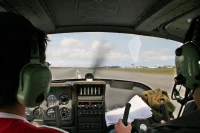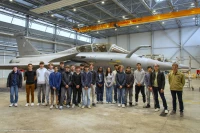It was the big day — the one that comes at the end of a year of classes, flights, and visits, and which checks whether the knowledge acquired is enough to award the Brevet d’Initiation Aéronautique. On the agenda: 2 hours and 30 minutes and 100 single-choice questions divided into 5 sections: 20 questions on Meteorology and Aerology, 20 questions on Aerodynamics, Aerostatics, and Principles of Flight, 20 questions on Aircraft and Spacecraft Studies, 20 questions on Navigation, Regulations, and Flight Safety, and 20 questions on the History and Culture of Aeronautics and Space. And for those who registered for the optional test, there were 20 additional questions in Aviation English. A comprehensive test, for which candidates are trained in flying clubs, at their high schools — and sometimes even in middle schools, though they may still be a bit young to grasp the concepts behind the knowledge.
A BIA session focused on the essentials
This 2025 exam confirms the slow but steady evolution of the BIA towards a broad foundation of knowledge and realistic situations that give meaning and coherence to each set of questions. No surprises then in this 2025 session. Whereas previous editions were riddled with questions well beyond the reach of a young person taking their first steps in the aviation sector — such as the question about the bypass ratio of a turbofan engine in the 2024 session. Or those aimed more at highlighting BIA partners, as in the 2022 session which asked candidates to state the number of ULM (microlight) categories, and two questions later, to give the category number of the paramotor. These were hardly shining examples — neither for the BIA nor for the French Microlight Federation. So many questions that even certified pilots might not be able to answer. So many pitfalls avoided by the 2025 session. Thanks to the exam designers.
The tricky questions
That said, some questions still raise concerns — traps, poorly worded, ambiguous, or simply beyond the candidates' reach. Like question 2.9 in the Aerodynamics, Aerostatics, and Principles of Flight section, which asks about the effect of dihedral and sweep on stability. We knew that dihedral improves stability, but the effect of sweep seems to depend more on speed. Question 3.10 in the Aircraft and Spacecraft Studies section uses the letters A, B, C, and D both as answers and as markers, which creates confusion. Question 3.14 uses a negation, as candidates must identify the incorrect classification — tricky for those who read too quickly! There’s still a partner-focused question in 3.17, dealing with SAF, a more eco-friendly aviation fuel. And perhaps the BIA goes a little too far with question 4.3 in the Navigation, Regulations, and Flight Safety section, which addresses airworthiness — a complex topic. Still, overall, this exam aligns well with the expectations for a future BIA certificate holder. It's a clear improvement over previous editions. While we wait for the official results, here’s my personal answer key for the core exams and for the optional Aviation English test. Feedback welcome on X or Threads.




